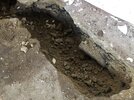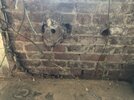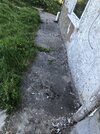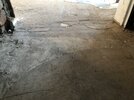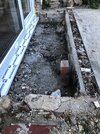Ive searched this topic in the forums, but all the hits seem to be very old .. so hoping there may be some updated information available. My house is estimated from around 1900 and has everything wrong with it, including quite a bit of movement. One of the endless list of issues is damp patches on the very uneven concrete kitchen floor (which is well below outside level and approx 1cm below level of adjoining hallway). Ive dug out the part of the floor which had the biggest damp patch, and found only wet compacted earth (no puddles), under the sand/DPM/1.5 inch concrete/thin screed. I didnt find any pipework etc. Im then assuming that the DPM under the concrete has failed where the damp patches are, so wondering if I can simply lay another DPM on top of current concrete (after filling in my hole) and screeding on top of that? Or do i need to dig out concrete of whole floor (4.5x4m) and start again?
Or indeed am i missing the obvious in my search for pipework possibly?
Probably not helping with the damp ground is the external concrete path which almost abuts the rendered house walls, with just a small gap (1mm) between the two along most of the house walls. I was thinking to fill these gaps with concrete or caulk. Would that be the correct thing to do I wonder?..
And i was also considering a chemical injected DPM - to cover all angles. Would it be worth it?
The structural surveyor suggested I spend as little as possible in making the house liveable for the 5 years I anticipated staying here .. as its not going to be an easy place to sell, when the time comes. So this is also a consideration. Any guidance would be hugely appreciated.
Or indeed am i missing the obvious in my search for pipework possibly?
Probably not helping with the damp ground is the external concrete path which almost abuts the rendered house walls, with just a small gap (1mm) between the two along most of the house walls. I was thinking to fill these gaps with concrete or caulk. Would that be the correct thing to do I wonder?..
And i was also considering a chemical injected DPM - to cover all angles. Would it be worth it?
The structural surveyor suggested I spend as little as possible in making the house liveable for the 5 years I anticipated staying here .. as its not going to be an easy place to sell, when the time comes. So this is also a consideration. Any guidance would be hugely appreciated.


